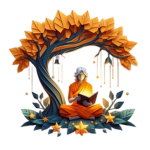This normally simplistic concept of death brings forth existential dread, whereas Hindu philosophy so problematically unveils the deep tenets of Atma Vidya (knowledge of the soul) that changes how we grapple with mortality. This ancient wisdom is thus a framework for not merely accepting death, but transcending this finality that it is.
Eternal Soul (Atman)
At the root of Indian metaphysics is the concept of _Atman_ — the immortal and unchangeable soul. Unlike a temporary physical body, the Atman represents one's true self. The Bhagavad Gita (2:20) beautifully states:
"For the soul there is neither birth nor death. It has not come into being, does not come into being, and will not come into being. It is unborn, eternal, ever-existing, and primeval. It is not slain when the body is slain."
According to this verse, what we rather call "death" is really a transition for the soul, not an end. The Katha Upanishad (1.2.18) reinforces this:
"The self is neither born nor does it die. It has come from something nor has anything come from it. This unborn, eternal, everlasting, ancient one is not slain when the body is slain."
The Cycle of Samsara
It is cyclical rather than linear, to exist in Hindu philosophy. A soul has thousands of births and deaths in the cycle of _samsara_ (rebirth). In Bhagavad Gita (2:22), the quotes resulting out of this are:
"As a person puts on new garments, giving up old ones, the soul similarly accepts new material bodies, giving up the old and useless ones."
Change of garments, in every sense essential and natural, not seizable by fear, may here be considered to be death itself. The Brihadaranyaka Upanishad (4.4.3) expounds thus:
"Just as a caterpillar, having reached the end of a blade of grass, takes hold of another blade and draws itself to it, so the Self, having left one body behind, takes hold of another and draws itself to it."
Maya and Illusion of Death
Attachment to the mortal body and the material world—what Hindu philosophy distinguishes as _maya_ (illusion)—is what frightens from dying. According to the Chandogya Upanishad (6.9.3),
"That which is the subtle essence – in that have all beings their existence. That is the Truth. That is the Self. That thou art, Svetaketu."
The saying Tat Tvam Asi materializes the individuality and universality of consciousness; thus, it clearly indicates how fear of death is misidentification with the temporary body.
Separation from Death (Moksha)
And the last point is moksha: liberation from the cycle of birth and death. What brings moksha is self-realization and recognition of who we are. One discovers liberation in the Mundaka Upanishad (3.2.9):
"He who knows the Supreme Brahman becomes Brahman. In his family, no one remains ignorant of Brahman. He crosses over sorrow and sin and, freed from the knots of the heart, becomes immortal."
Through meditation, yoga, and devotion, man may experience this truth rather than acquire it at the intellectual level.
Approach to Death Practically
For all those drawn towards Hindu philosophy, these teachings provide practicable approaches to death:
1. Understand that your essence is immortal
2. Practice dispassion from the physical body and worldly possessions
3. Learn to develop universal consciousness within you through awareness
4. Live ethically: dharma (righteous duty)
5. Develop meditation practices which reveal your true nature at master level
According to Yoga Sutras of Patanjali (2:9), death is one of the five principal _kleshas_ (afflictions) to be overcome along the spiritual path. Death loses its sting then through understanding Atma Vidya, simply a transition in an eternal journey for the soul.
Hinduism does not argue that we must ignore death, but rather see beyond it: that is, to sense the deathless essence that we truly are. Doing this brings not just solace, but very profound freedom.

.png)
0 Comments